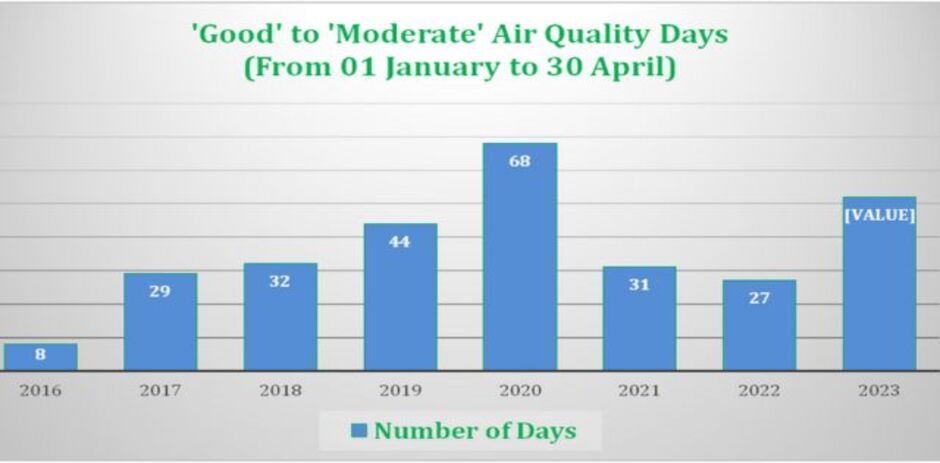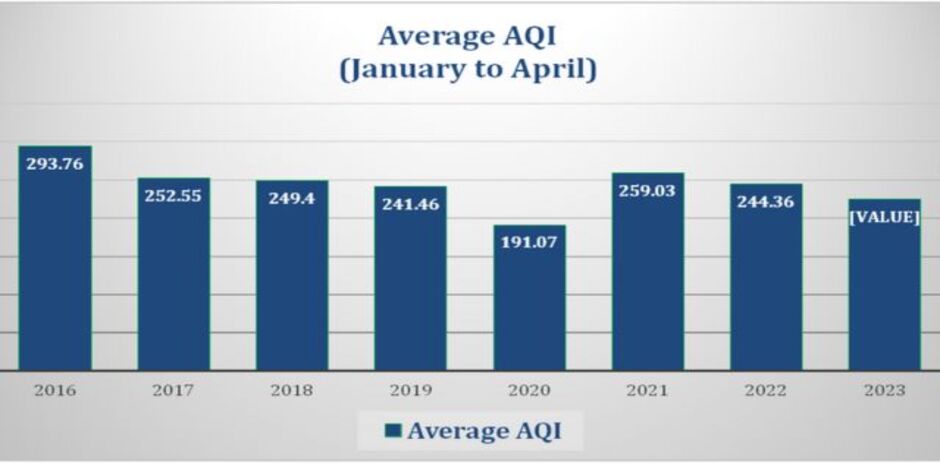As per Air Quality Index (AQI) data of the Central Pollution Control Board (CPCB), Delhi has witnessed maximum number of days with ‘Good to Moderate’ Air Quality during the first four months’ period of 2023 (i.e. January to April), as compared to the corresponding period of last 07 years since 2016 (barring the periods of very low anthropogenic, industrial and commercial activities during the Covid-19 lockdown year 2020).
A comparative chart for days with ‘Good to Moderate’ AQI witnessed for the first four months’ period during the 08 years (2016-2023) is depicted below:

Air Quality Index Delhi’s Air Quality Index (AQI) is a measure of the air quality in the city, which is determined by the concentration of pollutants in the air. The AQI is calculated based on the levels of five pollutants: particulate matter (PM2.5 and PM10), nitrogen dioxide (NO2), ozone (O3), carbon monoxide (CO) and sulfur dioxide (SO2). The AQI is a scale from 0 to 500, with 0 being the best air quality and 500 being the worst.
The number of ‘Good to Moderate’ Air Quality Days for the first four months’ period (i.e. January to April) were 08 in the year 2016; 29 in 2017; 32 in 2018; 44 in 2019; 68 in 2020; 31 in 2021; 27 in 2022; and 52 in the current year 2023.
During this period, Delhi has also experienced least number of days with ‘Poor to Severe’ Air Quality in 2023, as compared to the corresponding period of last 07 years since 2016 (except 2020 – year of Covid lockdown).
The number of ‘Poor to Severe’ Air Quality Days for the first four months’ period (i.e. January to April) have come down by 37.03% i.e. from 108 in the year 2016 to 68 in the current year 2023.
In terms of daily average PM2.5 concentration levels in Delhi, 2023 has been the year with lowest levels of daily average PM2.5 concentration, as compared to the corresponding period for last 07 years i.e. from 2016 (barring 2020 – the year of Covid lockdown). Moreover, 2023 has also been the year with lowest levels of daily average PM10 concentration in Delhi, as compared to the corresponding period for last 07 years i.e. from 2016 (barring 2020 – the year of Covid lockdown). A comparative chart depicting the PM10 and PM2.5 running average (µg/m3) for the first four months’ period (January – April) during the 08 years (2016-2023) is given below:

Health problems associated with poor air quality
Air pollution is a major environmental health hazard in Delhi, and is responsible for a wide range of health problems. The most common health effects of air pollution are respiratory and cardiovascular diseases, such as asthma, bronchitis, and heart disease. Air pollution can also cause irritation of the eyes, nose, and throat, and can aggravate existing conditions such as allergies and asthma.
In addition to these health effects, air pollution in Delhi has been linked to an increased risk of cancer. Studies have shown that people living in areas with high levels of air pollution are more likely to develop certain types of cancer, such as lung cancer. Air pollution has also been linked to an increased risk of birth defects, premature births, and low birth weight.
Air pollution in Delhi is also linked to a number of other health problems, such as fatigue, headaches, dizziness, and nausea. In addition, air pollution has been linked to an increased risk of mental health problems, such as depression and anxiety.
The health effects of air pollution in Delhi are particularly severe for children and the elderly. Children are more vulnerable to the health effects of air pollution due to their smaller size and immature immune systems. The elderly are also more vulnerable to the health effects of air pollution due to their weakened immune systems.

AIR QUALITY SCENARIO FOR THE PERIOD
JANUARY – APRIL, 2023
- Delhi witnesses the maximum number of ‘Good’ to ‘Moderate’ Air Quality days during the first 04 months’ period of current year (i.e. January to April), as compared to the corresponding period for last 07 years i.e. from 2016 (barring 2020 – the year of Covid lockdown);
- The number of ‘Good to Moderate’ Air Quality Days in Delhi was 08 in 2016 and 52 in 2023 for the corresponding period;
- Delhi has also experienced the least number of days with ‘Poor to Severe’ Air Quality during this period, as compared to the corresponding period for last 07 years i.e. from 2016 (except 2020 – year of Covid lockdown);
- The number of ‘Poor to Severe’ Air Quality Days in Delhi was 108 in 2016 and 68 in 2023;
- 2023 has seen the lowest levels of daily average PM2.5 concentration in Delhi as compared to the corresponding period for last 07 years i.e. from 2016 (barring 2020 – the year of Covid lockdown);
- 2023 has also been the year with lowest levels of daily average PM10 concentration in Delhi as compared to the corresponding period for last 07 years i.e. from 2016 (barring 2020 – the year of Covid lockdown);
- Delhi also reports its lowest Daily Average AQI in 2023 compared to the corresponding period for last 07 years i.e. from 2016 (barring 2020 – the year of Covid lockdown);
- Persistent field-level efforts and targeted policy initiatives in the short/ medium/ long term are expected to result in gradual but marked improvement in Air Quality.
Source of air pollution
Natural sources of air pollution in Delhi include dust storms, wildfires, and volcanic eruptions. These sources are not under human control and can cause a significant amount of air pollution.
Man-made sources of air pollution in Delhi are the most significant contributors to the city’s air pollution problem. These sources include burning of fossil fuels, vehicular emissions, industrial emissions, construction activities, and burning of biomass.
Burning of fossil fuels is one of the major sources of air pollution in Delhi. The burning of coal, petroleum, and natural gas for energy production and transportation releases harmful pollutants such as carbon dioxide, nitrogen oxides, and sulfur dioxide into the atmosphere. These pollutants can cause respiratory and cardiovascular diseases.
Vehicular emissions are another major source of air pollution in Delhi. The city has a large number of vehicles, which emit harmful pollutants such as carbon monoxide, nitrogen oxides, and particulate matter. These pollutants can cause respiratory problems and other health issues.
Industrial emissions are also a major source of air pollution in Delhi. Industries such as power plants, chemical plants, and refineries release pollutants such as sulfur dioxide, nitrogen oxides, and particulate matter into the atmosphere. These pollutants can cause respiratory and cardiovascular diseases.
Construction activities are another major source of air pollution in Delhi. The construction of roads, buildings, and other infrastructure releases dust and other pollutants into the atmosphere. These pollutants can cause respiratory problems and other health issues.
Burning of biomass is also a major source of air pollution in Delhi. The burning of wood, crop residue, and other biomass releases pollutants such as particulate matter, carbon monoxide, and nitrogen oxides into the atmosphere. These pollutants can cause respiratory and cardiovascular diseases.
Air pollution in Delhi is a major concern due to its severe health impacts. The sources of air pollution in Delhi are both natural and man-made. It is important to reduce the emissions from these sources in order to reduce air pollution in Delhi and improve the health of its citizens. Government Initiatives to Improve Delhi’s Air Quality The Government of Delhi has taken a number of initiatives to improve the air quality in the city. These initiatives have been implemented to reduce air pollution and to make Delhi a healthier and more livable city.
The first initiative was the introduction of the Delhi Air Quality Improvement Program (DAQIP). This program was launched in 2017 and focuses on reducing air pollution in the city. It includes a number of measures such as increasing public awareness about air pollution, implementing emission control measures, and strengthening enforcement of existing laws and regulations. The program also includes the installation of air quality monitoring stations across the city, which provide real-time data on air quality.
The second initiative is the introduction of the Odd-Even Scheme. This scheme was launched in 2016 and requires vehicles with odd-numbered registration plates to be driven on odd-numbered days, and vehicles with even-numbered registration plates to be driven on even-numbered days. This scheme has been effective in reducing the number of vehicles on the roads and thus reducing air pollution.
The third initiative is the introduction of the Graded Response Action Plan (GRAP). This plan was launched in 2017 and is a comprehensive plan to tackle air pollution in Delhi. It includes a number of measures such as increasing public awareness about air pollution, introducing emission control measures, and strengthening enforcement of existing laws and regulations.
The fourth initiative is the introduction of the Green Delhi Scheme. This scheme was launched in 2018 and focuses on increasing green cover in the city. It includes measures such as increasing the number of trees in the city, creating green spaces, and encouraging the use of public transport.
The fifth initiative is the introduction of the Delhi Electric Vehicle Policy. This policy was launched in 2019 and aims to promote the use of electric vehicles in the city. It includes measures such as providing incentives for the purchase of electric vehicles, setting up charging infrastructure, and creating awareness about electric vehicles.
Protection
1. Wear a Mask: Wearing a mask is one of the most effective ways to protect yourself from Delhi’s air pollution. Make sure to wear a mask that is designed to filter out particulate matter.
2. Avoid Outdoor Activities: Avoid outdoor activities when the air quality is poor. This is especially important for children and elderly people who are more vulnerable to the effects of air pollution.
3. Stay Indoors: If possible, stay indoors when the air quality is poor. Make sure to keep your windows and doors closed to keep the polluted air out.
4. Use Air Purifiers: Air purifiers can help to reduce the levels of air pollution in your home. Make sure to use a high-quality air purifier that is designed to filter out particulate matter.
5. Avoid Polluted Areas: Avoid areas that are known to be heavily polluted, such as industrial areas and busy roads.
6. Take Vitamin Supplements: Taking vitamin supplements can help to reduce the effects of air pollution on your body. Make sure to consult your doctor before taking any supplements.
7. Drink Plenty of Water: Drinking plenty of water can help to flush out toxins from your body. Make sure to drink at least 8 glasses of water a day.



